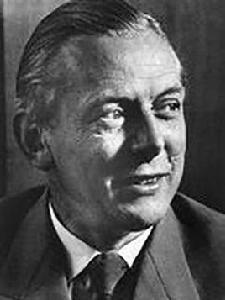個人履歷
Adolf Butenandt(1903年3月24日—1995年2月18號)
全名:Adolf Frederick Johann Butenandt
布特南特在馬爾堡大學學習,其後在格廷根大學溫道斯的指導下工作,並於1927年獲得化學博士學位。三年之後他是那裡的有機化學實驗室主任。 布特南特突出的工作是分離性激素和鑑定其結構。第一個被分離出來的性激素是雌酮,這是布特南特在1929年從懷孕婦女的尿中得到的。它是卵巢細胞分泌出來的少量幾種物質之一,這些物質是促進婦女性成熟的。1931年布特南特分離出雄性甾酮,這是睪丸細胞產生的一種重要的男性激素,它對男人所起的作用如同雌酮對婦女所起的作用一樣。布特南特只用了15毫克的雄性甾酮,由於採用了普萊格爾所用的微量分析法,得以對這些元素作了兩次分析,而且還制出這個化合物的一種變體並分析了它。這足以使布特南特有可能推導出這個化合物的分子式。1934年盧齊契加根據布特南特的結構見解合成了一種類似的化合物,發現合成的產物完全具有雄性甾酮的性質,因此證實布特南特的探索工作是正確的。1934年布特南特分離了另外一種對於妊娠過程中的化學機理具有十分重要作用的女性激素---孕甾酮。1936年布特南特擔任柏林威廉皇家生物化學研究所所長,1939年他與盧齊卡(Leopold Ruzicka 1887—1976)分享了諾貝爾化學獎。如同那年另一位德國人多馬克以及一年前庫恩得到諾貝爾獎時的情況一樣,納粹政府強迫布特南特拒絕接受這筆獎金。直到第二次世界大戰結束和希特勒完蛋後,他才於1949年接受了這一榮譽。戰後他在圖賓根大學任教,1956年之後在慕尼黑大學教書。1960年他繼哈恩之後任馬克斯·普朗克學會主席。
英文介紹
Adolf Frederick Johann Butenandt was born on March 24, 1903 at Bremerhaven-Wesermünde. The son of a business man Otto Butenandt of Hamburg, he went to school at Bremerhaven and studied chemistry at the Universities of Marburg and Göttingen. In 1927 he graduated at the University of Göttingen, where he had studied under Adolf Windaus.
From 1927 until 1930 he was Scientific Assistant at the Institute of Chemistry, Göttingen, and from 1931 until 1933 he was Privatdozent in the Department of Biological Chemistry at the University of Göttingen and acting Head of the laboratories for organic and inorganic chemistry. He then became Professor Ordinarius and Director of the Institute for Organic Chemistry at the Institute of Technology at Danzig, a post which he held until 1936.
From 1936 until 1960 he was Professor in the University of Berlin and Director of the Max Planck Institute for Biochemistry, Berlin-Dahlem, which later moved to Tübingen and then to Munich. From 1945 until 1956 he was Professor of Physiological Chemistry at Tübingen and in 1956 he became Professor of Physiological Chemistry in the University of Munich. From 1956 until 1960 he was Director of the Institute of Physiological Chemistry in the University of Munich.
Since 1960 he has been President of the Max Planck Society at Munich.
Butenandt's name will always be associated with his work on sex hormones, for which he was awarded, jointly with Leopold Ruzicka, the Nobel Prize for Chemistry for 1939. In 1929 he isolated oestrone in pure, crystalline form, almost at the same time that E.A. Doisy did this in America. In 1931 he isolated androsterone in pure, crystalline form. From androsterone he as well as Ruzicka, independently of each other, obtained testosterone in 1939, a compound which had been obtained from the testes in 1935 by Ernst Laqueur. Progesterone was isolated by Butenandt from the corpus luteum in 1934.
In addition to these researches, Butenandt carried out much investigation of the interrelationships of the sex hormones and on the possible carcinogenic properties of some of them. His work on the sex hormones was largely responsible for the production of cortisone on a large scale.
A great number of honours and distinctions was bestowed upon him. He was awarded several medals and prizes from Germany, France, Sweden and England, he received the Grand Cross for Federal Services with Star (1959), he holds six honorary doctorates (Munich, Graz, Leeds, Madrid and two from Tübingen) and is Freeman of the city of Bremerhaven. He is corresponding member of the Academy of Sciences at Göttingen, honorary life member of the New York Academy of Sciences, and honorary member of the Japanese Biochemical Society, the Deutsche Akademie der Naturforscher Leopoldina, Halle, and the Austrian Academy of Sciences.
He married Erika Ziegner in 1931; they have seven children and live at Munich-Obermenzing.
From Nobel Lectures, Chemistry 1922-1941, Elsevier Publishing Company, Amsterdam, 1966
This autobiography/biography was first published in the book series Les Prix Nobel. It was later edited and republished in Nobel Lectures. To cite this document, always state the source as shown above.
Adolf Butenandt died on January 18, 1995.
睪酮
1931年德國化學家布特南特(Adolf Frederick Johann Butenandt)從睪丸里分離出一種雄性激素——睪酮,後來確認是從睪丸的間質細胞產生的。它對男人所起的性徵作用如同雌酮對婦女所起的作用一樣。1934年盧齊契加根據布特南特的結構見解,合成了一種類似的化合物,發現合成的產物完全具有睪酮的性質,因此證實布特南特的探索工作是正確的。1939年他們兩人獲諾貝爾化學獎。
雄、雌性激素影響免疫系統的方式及其分子機制:性激素作用於免疫系統的三種方式是:(1)改變T、B細胞表型和細胞功能;(2)影響Ig水平及Ig合成動力學;(3)影響細胞因子的合成,進而增強或削弱免疫應答。
性激素髮揮作用的共同分子機制為:游離性激素經被動擴散進入靶細胞,與特異性受體結合形成複合物,經過一系列變化,受體分子激活,而後與特異DNA片段呈高親和力結合,該片段作為轉錄因子轉錄相應的核糖核酸(mRNA),進而翻譯為活性蛋白質,產生生物效應。免疫器官中雄性激素受體的存在尚有爭議,但已證實人胸腺細胞、T淋巴細胞和滑膜內巨噬細胞有雌激素受體。
早在公元前1500年人們就注意到動物和人的胸腺,但是卻不知道它存在的意義。1961年澳大利亞免疫學家米勒(J.F.A.P.Miller)發現胸腺淋巴細胞的免疫功能。認為胸腺是培育T淋巴細胞的中央淋巴器官。
到上世紀70年代人們注意到胸腺的生長發育隨動物和人的生長發育而發生的形態和功能變化。進而通過試驗證明:雄、雌激素均可誘導和外周淋巴器官的萎縮,而雄、雌性動物去勢後均可出現胸腺和脾臟增生。這預示,雄、雌性激素可能對免疫有抑制作用。
到上世紀80年代,由於臨床流行病學證據顯示,女性更容易患自身免疫性疾病,所以普遍認為雌激素能加強免疫應答,而雄性激素則抑制免疫應答。
1987年山東大學楊帆和他的導師王龍的研究報告顯示:雄性激素對免疫功能的作用表現出劑量-效應關係,即:睪酮高劑量時,表現出促進B淋巴細胞產生抗體的作用;睪酮低劑量時,表現T淋巴細胞轉化和巨噬細胞功能有明顯變化;而切除睪丸後,動物的T淋巴細胞轉化率明顯提高,B淋巴細胞抗體生成和巨噬細胞的吞噬功能沒有變化。因此,這兩位學者提出:“不能籠統地說雄性激素對免疫機能有促進作用還是抑制作用,必須注意到使用激素的量以及採用多方面的指標才能說明對免疫機能的確切作用。”
1989年冬天,遲阿魯使用甲基睪丸素(一種合成的雄性激素)治療感冒(未病因診斷,只做過血常規檢查),對成年人,甲基睪丸素1天服用3次,1次1片。接受治療的病人多在服藥1—2天症狀消失。1992年他撰寫了病例報告發表在《山東醫藥》第10期。他我採用該激素治療慢性鼻炎、慢性支氣管炎都有明顯的療效。
上世紀90年代,雄性激素對免疫功能調節的實驗研究和臨床報告逐漸增多,國外已有很多報告顯示:採用雄性激素治療愛滋病是有效的。有的報告顯示:病人的CD4細胞數量增加。
2003年SARS在國內流行期間,遲阿魯向有關部門和專家建議:適量採用雄性激素治療SARS,為的是提高病人免疫力,還可以改善症狀,減輕肺部炎症反應等。4月24日《中國醫學論壇報》發表了他的建議。之後,《健康報》在發表治療SARS的醫療專業人員的文章時,其治療綜述中提到了採用雄性激素的問題。
越來越多的文獻顯示,雄性激素對免疫功能的調節,存在劑量-效應的異質性。相信,隨著對雄性激素的認識深入,它定會發揮更廣泛的醫療作用。


